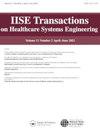Effectiveness of smart wrist wearables for distinguishing physical and cognitive demands
IF 1.5
Q3 HEALTH CARE SCIENCES & SERVICES
IISE Transactions on Healthcare Systems Engineering
Pub Date : 2022-11-01
DOI:10.1080/24725579.2022.2142867
引用次数: 0
Abstract
Abstract Wrist-worn wearables, with sensors to measure physiological responses such as heart rate variability (HRV) and electrodermal activity (EDA), have been increasing and have the potential to be used for continuous monitoring. These devices have been used to detect responses in workers’ physical and cognitive demands; however, the accuracy of wrist wearables for distinguishing these demands is unknown, especially since many every day and work activities frequently require motion. The objective of this study was to evaluate the effectiveness of a wrist-worn wearable in measuring physiological changes during different demand conditions. Participants (n = 20 college students) completed a multi-factor laboratory study that considered task (cognitive/physical), difficulty (easy/hard), and motion (motion/no motion). N-back tasks and stationary bike tasks were used to represent cognitive and physical demands, respectively. Metrics of HRV and EDA were measured using reference-standard devices and a validated wrist-wearable. Significant differences between task, motion, and difficulty were observed from HRV measurements from the reference-standard and wrist-worn devices. Wrist wearables are sensitive to detecting workplace demands and may be used as an alternative to reference-standard sensors for continuous health and activity monitoring for worker health and wellness. Findings in this study can provide guidelines on task and conditions that affect the use and interpretation of wrist-worn devices for measuring cognitive and physical demands in healthcare systems. HIGHLIGHTS Applications for noninvasive, wrist-worn sensors can be used for continuous health and exercise monitoring HRV and EDA metrics obtained from wrist-worn device are sensitivity in detecting changes in task, difficulty, and motion HRV metric from wrist-worn device had agreement with reference-standard device Wrist-wearables has potential for ubiquitous health monitoring of individuals智能手腕可穿戴设备区分身体和认知需求的有效性
摘要佩戴在手腕上的可穿戴设备,具有测量心率变异性(HRV)和皮肤电活动(EDA)等生理反应的传感器,一直在增加,并有可能用于连续监测。这些设备已被用于检测工人身体和认知需求的反应;然而,手腕可穿戴设备区分这些需求的准确性是未知的,特别是因为许多日常和工作活动经常需要运动。本研究的目的是评估手腕佩戴的可穿戴设备在不同需求条件下测量生理变化的有效性。参与者(n = 20名大学生)完成了一项多因素实验室研究,该研究考虑了任务(认知/身体)、难度(容易/难)和运动(运动/无运动)。N-back任务和固定自行车任务分别用于表示认知和身体需求。HRV和EDA的指标是使用参考标准设备和经过验证的手腕可穿戴设备进行测量的。从参考标准和腕戴设备的HRV测量中观察到任务、运动和难度之间的显著差异。手腕可穿戴设备对检测工作场所需求很敏感,可以作为参考标准传感器的替代品,用于持续监测工人的健康和活动。这项研究的发现可以为影响医疗系统中测量认知和身体需求的腕戴设备的使用和解释的任务和条件提供指导。亮点非侵入性腕戴式传感器的应用可用于持续健康和运动监测从腕戴式设备获得的HRV和EDA指标在检测任务、难度和运动变化方面具有敏感性腕戴式装置的HRV指标与参考标准装置一致腕戴式可穿戴设备有潜力对个人进行普遍的健康监测
本文章由计算机程序翻译,如有差异,请以英文原文为准。
求助全文
约1分钟内获得全文
求助全文
来源期刊

IISE Transactions on Healthcare Systems Engineering
Social Sciences-Safety Research
CiteScore
3.10
自引率
0.00%
发文量
19
期刊介绍:
IISE Transactions on Healthcare Systems Engineering aims to foster the healthcare systems community by publishing high quality papers that have a strong methodological focus and direct applicability to healthcare systems. Published quarterly, the journal supports research that explores: · Healthcare Operations Management · Medical Decision Making · Socio-Technical Systems Analysis related to healthcare · Quality Engineering · Healthcare Informatics · Healthcare Policy We are looking forward to accepting submissions that document the development and use of industrial and systems engineering tools and techniques including: · Healthcare operations research · Healthcare statistics · Healthcare information systems · Healthcare work measurement · Human factors/ergonomics applied to healthcare systems Research that explores the integration of these tools and techniques with those from other engineering and medical disciplines are also featured. We encourage the submission of clinical notes, or practice notes, to show the impact of contributions that will be published. We also encourage authors to collect an impact statement from their clinical partners to show the impact of research in the clinical practices.
 求助内容:
求助内容: 应助结果提醒方式:
应助结果提醒方式:


